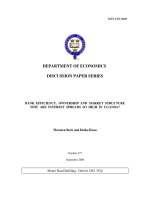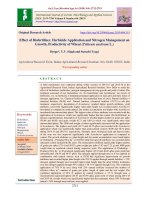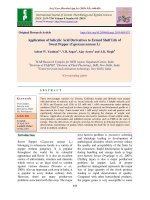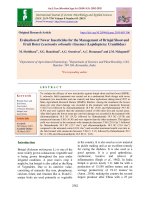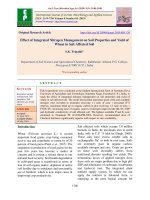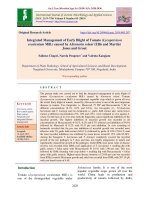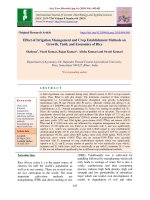Management of die back and fruit rot disease of chilli (Capsicum annum L.)
Bạn đang xem bản rút gọn của tài liệu. Xem và tải ngay bản đầy đủ của tài liệu tại đây (177.43 KB, 8 trang )
Int.J.Curr.Microbiol.App.Sci (2020) 9(3): 1235-1242
International Journal of Current Microbiology and Applied Sciences
ISSN: 2319-7706 Volume 9 Number 3 (2020)
Journal homepage:
Original Research Article
/>
Management of Die back and Fruit Rot Disease of
Chilli (Capsicum annum L.)
Akhilesh Patel1*, Ashish Kumar2, R. K. Tiwari1 and R. Shiv Ramakrishnan2
1
Jawaharlal Nehru Krishi Vishwa Vidyalaya (JNKVV) College of Agriculture,
Rewa, M.P. 486 001, India
2
Jawaharlal Nehru Krishi Vishwa Vidyalaya (JNKVV) College of Agriculture,
Jabalpur, M.P. 482 004, India
*Corresponding author
ABSTRACT
Keywords
Chilli, Die back and
Fruit rot,
Trichoderma
Article Info
Accepted:
05 February 2020
Available Online:
10 March 2020
Die-back and fruit rot diseases are major yield limiting factor in all chilli growing
areas of India. Trichoderma species are commonly used as biological control
agents against phytopathogenic fungi and represent differential capacity of
antagonism. In the present investigation, the effect of seven native Trichoderma
isolates from Madhya Pradesh was examined for management of chilli die back
and fruit rot using seed treatment with three foliar sprays of respective isolate.
Different isolates of Trichoderma spp. significantly inhibited the growth of
Colletotrichum capsici causing die-back and fruit rot in chilli under confrontation
assay and maximum inhibition of 39.29% was recorded by Trichoderma isolate
T2(REWA) after 96 hrs of incubation period. In field conditions, among treatments
with different Trichoderma isolates, it was observed that minimum PDI of 19.40%
was recorded in seed treatment and three foliar sprays with T 2 isolate of
Trichoderma with maximum yield of 69.55q/ha. Among different fungicides
evaluated, minimum PDI of 21.47% was recorded in foliar spray with
propiconazole @0.1%. This was followed by foliar spray with Thiram + Carboxin
@0.2% where 23.73 % PDI was recorded.
Introduction
Chilli (Capsicum annum L.) is an important
spice cum vegetable crop, often referred to as
Capsicum, hot pepper, sweet pepper or
paparika. Chilli cultivation has existed for
several hundred years as a sustainable form of
agriculture in India and in many other
countries. India stands 3rd in production of
chillies (Saxena et al., 2016) and Capsicum
annuum is the widely cultivated species.
Green chilli provides vitamin-C while, the red
chilli provides vitamin-A (Martin et al., 2004)
in addition to iron, potassium and magnesium.
The area and production of green chillies in
India is 0.316 mha and 3.63 mt respectively
1235
Int.J.Curr.Microbiol.App.Sci (2020) 9(3): 1235-1242
during the year, 2016-17 (Anonymous, 2017).
The sustainability of chilli-based agriculture
is threatened by a number of biotic and
abiotic factors. The chilli suffers from more
than 40 fungal species and of these
Colletotrichum capsici is one of the most
caustic species causing leaf spot or die back at
different stages of crop growth and fruit rot or
anthracnose at fruiting stage leading to
reduced fruit yield and marketability.
Although infected fruits are not toxic to
humans or animals, severely affected fruits
showing blemishes are generally considered
unfit for human consumption. This is because
the fruit rot causes an unpleasant colour and
taste in it’s products. Studies conducted on
resistance aspect of this disease show very
little resistance in chilli germplasm which
indicate the presence of diverse population
within the fruit rot/dieback or anthracnose
causing fungus. Management of the disease
under the prevailing farming systems in India
has, thus, become a recurrent problem to chilli
growers. The disease can be kept under check
with chemical spray programme (Thind and
Jhooty, 1987; Datar et al., 1990; Sharma and
Thakore, 1999; Rathore, 2004) but the
complete control is still intractable.
Trichoderma, a filamentous soil inhabiting
mycoparasite, is used in commercial
preparation for biological control of many
fungal plant pathogens (Jash, 2006) and
included the mechanisms like antibiosis,
competition for nutrients or space, tolerance
to stress through enhanced root and plant
development,
induced
resistance,
solublization and sequestration of inorganic
nutrients and inactivation of pathogen
enzymes (Harman, 2000). However, with the
increasing interest in biological control,
owing to environmental and economic
concerns, and with the rapid development of
biotechnology, several Trichoderma species
were formulated in a commercial production
for protection and growth enhancement of a
number of crops in several countries
(McSpadden and Fravel, 2002). It is always
beneficial that the selected strain of
Trichoderma should have the ability to
compete with the native microflora, establish
itself successfully in the crop rhizhoshere/
spermosphere and should have a wide array of
mechanisms to inhibit several pathogens.
Given these considerations, it is expected that
the best method for obtaining a potential
biocontrol agent might be to isolate
Trichoderma strains originally from those
areas where they are actually expected to
function later as a biocontrol agent and where
they are already growing under conditions of
temperature, moisture etc. similar to those
found in nature (Howell, 2003). Keeping this
in view, the present investigation was
envisaged to use the native isolate of
Trichoderma in management of die back and
fruit rot of chilli.
Materials and Methods
Trichoderma harzianum isolates
A set of seven T. harzianum isolates of were
procured from Department of Plant
Pathology, College of Agriculture, Rewa and
further used in present investigation. The
isolates were isolated from soil samples
collected from Satna, Rewa (Kuthulia),
Khargone, Indore, Umaria, Rewa (Birkham)
and Sidhi locations of Madhya Pradesh and
coded as T1, T2, T3, T4, T5, T6 and T7
respectively. The procured isolates of T.
harzianum were maintained throughout the
study by periodical transfers on Potato
dextrose agar (PDA) medium.
Dual culture experiment (Confrontation
assay)
Antagonistic efficacy of different isolates of
Trichoderma spp. was tested C. capsici by
dual culture experiment using confrontation
1236
Int.J.Curr.Microbiol.App.Sci (2020) 9(3): 1235-1242
assay (Kumar et al., 2010). Trichoderma spp.
and test fungus was inoculated at 7 cm apart.
Four replicates were maintained for each
treatment and incubated at 28 ± 2° C for 4
days. Monoculture plates of both served as
control. Radial growth of test fungus and
Trichoderma isolates were measured three
and four days after inoculation (DAI). Radial
growth of test fungus in dual culture plate was
recorded and compared with control. The
growth inhibition was calculated by using the
formula: 100 X C - T / C, Where C = radial
growth of test pathogen in control and T =
radial growth of test pathogen in treatment
(Vincent, 1947).
Management of die back and fruit rot of
chilli
Experiment was conducted in experimental
area of Department of Plant Pathology,
J.N.K.V.V., College of Agriculture, Rewa.
The seeds of chilli cv. Kohinoor special were
sown in lines at a spacing of about 5 cm apart
on raised beds of about 15 cm above ground
level and covered with soil, thereafter,
mulched with dry grasses. Appropriate
moisture level was maintained for proper
growth of the seedlings. Dry grass was
removed to expose the seedlings to sunlight
for better growth after germination. The
seedlings were transplanted to individual plot
size of 1.5 m × 2.5 m with row to row and
plant to plant spacing of .75 m and 0.30 m
respectively. For biological management of
die back and fruit rot disease slurry of
different isolates of Trichoderma was
prepared separately for each isolate and seeds
were treated @10 g/kg seed. Seeds were
dipped in the slurry for 30 minutes and dried
in shade before sowing. For foliar spray, the
first spray was given 25 days after
transplanting followed by two more sprays at
15 days interval. The spray solution was
prepared by adding 2.5 g culture of
Trichoderma separately in 1 litre of water. In
total seven treatments were formulated using
different isolates of Trichoderma (T1 to T7) as
seed treatment followed by three foliar sprays
of respective isolate.
Further, for chemical management of die back
and fruit rot in chilli a set of five fungicides
including
systemic
and
non-systemic
fungicides viz., Propiconazole (Tilt 25 EC) @
0.1%, Carboxin 37.5 per cent + Thiram 37.5
per cent (Vitavax power) @ 0.2%, Captan
(Captaf 50WP) @ 0.2%, Thiram (Thiram 50
WP) @ 0.1% and Carbendazim (Bavistin
50% WP) @ 0.1% were evaluated for their
efficacy under field conditions. Treatments
were laid out in plots arranged in a
Randomized Block Design (RBD). Four
replications were maintained for each
treatment and fungicides were applied as
water-based spray liquid at specified
concentrations using a hand-held low volume
electric sprayer. The first spray of fungicides
was applied after appearance of disease in
field and two subsequent sprays were given at
20-day intervals. Disease incidence was
assessed on 15 days after last spray based on a
disease rating scale (Score 0, 1, 2, 3, 4 for
respectively 0, 1–5%, 6–25%, 26–50% and
51–100% fruit area infected) as proposed by
Bansal and Grover (1969). Per cent disease
index (PDI) was calculated according to
following formula given by Wheeler (1969)
and data collected were subjected to
Randomized Design for their significance
(Gomez and Gomez, 1984).
PDI = Sum of all disease ratings x 100/Total
no. of observations x Maximum disease rating
Results and Discussion
Confrontation assay
All the isolates of Trichoderma tested for
antagonistic activity against C. capsici
showed different degree of antagonism to the
pathogen and inhibited the test pathogen by
its mycoparasitic activity. Phenomenon of
1237
Int.J.Curr.Microbiol.App.Sci (2020) 9(3): 1235-1242
inhibition could be noticed by growth check
of the pathogen in treatment plate with
Trichoderma under confrontation assay.
However, mycoparasitic activity could be
visualized by over growth of Trichoderma
isolate above test pathogen. Under in-vitro
conditions, radial growth of C. capsici ranged
from 13.67 mm to 21 mm and 17 mm to 28
mm respectively after 72 hrs and 96 hrs of
incubation period in different treatments with
Trichoderma and control plate. After 96 hours
of incubation, growth of test pathogen C.
capsici was checked and Trichoderma starts
overlapping the pathogen. This shows their
mycoparasitic activity against the pathogen.
After 72 hrs and 96 hrs of incubation period,
maximum inhibition of respectively 34.92%
and 39.29% was recorded by Trichoderma
isolate T2(REWA). Prolonged incubation of
96 hours also depicted same isolate
T2(REWA) inhibiting maximum growth of R.
solani (54.2%). Detailed data for radial
growth and per cent inhibition after 72 hours
and 96 hours of incubation period of each
isolate of Trichoderma are given in table 1.
Management of die back and fruit rot of
chilli
Different isolates of Trichoderma spp. were
applied as seed treatment and three foliar
sprays at 15 days intervals to identify their
role in die back and fruit rot management in
chilli under field conditions and it was
observed that all the seven isolates were able
to control the disease. The maximum PDI of
32.49% was recorded in control. However,
among treatments with different Trichoderma
isolates, it was observed that minimum PDI of
19.40% was recorded in seed treatment and
three foliar sprays with T2 isolate of
Trichoderma. Maximum per cent inhibition of
40.29% was recorded in treatment T2 with
maximum yield of 69.55 q/ha. However, in
control plot minimum yield of 58.46 q/ha was
recorded. This clearly demonstrated the
disease inhibition and plant growth promotion
activity of Trichoderma. The detailed data for
different treatments for PDI and yield are
presented in table 2.
Table.1 Table 1: Average radial growth and per cent inhibition in growth of C. capsici by
isolates of Trichoderma after 72 and 96 hours incubation period
Treatment
Incubation Period
(Trichoderma
(72 hours)
isolate)
Avg. radial growth Per cent
(mm) of C. capsici inhibition
15.33
26.98
T1
13.67
34.92
T2
14.33
31.75
T3
17.33
17.46
T4
14.67
30.16
T5
18.33
12.70
T6
17.33
17.46
T7
21.00
0.00
Control
0.43
S.Em±
1.29
C.D. (p=0.05)
1238
Incubation Period
(96 hours)
Avg. radial growth Per cent
(mm) of C. capsici inhibition
18.33
34.52
17.00
39.29
17.33
38.10
20.00
28.57
17.33
38.10
21.00
25.00
20.67
26.19
28.00
0.00
0.51
1.55
-
Int.J.Curr.Microbiol.App.Sci (2020) 9(3): 1235-1242
Table.2 Effect of different isolates of Trichoderma in management of die back and fruit rot chilli
under field conditions
PDI*
Treatments
18.52
(25.42)
11.11
(19.40)
12.59
(20.66)
19.26
(25.92)
17.78
(24.90)
21.48
(27.58)
20.74
(27.07)
28.89
(32.49)
1.09
3.34
7.44
T1:Seed treatment with Trichoderma isolate
T1 with its three foliar sprays
T2:Seed treatment with Trichoderma isolate
T2 with its three foliar sprays
T3:Seed treatment with Trichoderma isolate
T3 with its three foliar sprays
T4:Seed treatment with Trichoderma isolate
T4 with its three foliar sprays
T5:Seed treatment with Trichoderma isolate
T5 with its three foliar sprays
T6:Seed treatment with Trichoderma isolate
T6 with its three foliar sprays
T7:Seed treatment with Trichoderma isolate
T7 with its three foliar sprays
T8:Control
S.Em±
C.D. (p=0.05)
CV %
Per cent
disease
reduction (%)
21.76
Yield
(q/ha)
40.29
69.55
36.41
63.22
20.22
61.36
23.36
68.27
15.11
59.27
16.68
59.87
0.00
58.46
65.58
2.52
8.79
6.92
Table 3: Effect of different fungicides in management of die back and fruit rot of chilli under
field conditions
Fungicide
Propiconazole
Thiram + Carboxin
Captan
Thiram
Carbendazim
Control
C.D. (p=0.05)
CV %
Dose (%)
PDI
Per cent disease reduction (%)
0.1
0.2
0.2
0.1
0.2
13.43 (21.47)
16.20 (23.73)
18.06 (25.18)
20.83 (27.13)
25.93 (30.59)
34.72 (36.09)
2.22
6.78
40.51
34.25
30.23
24.83
15.24
0.00
Among different fungicides evaluated, it was
observed that all the five fungicides were able
to manage the disease but degree of
management significantly varied among the
treatments. Minimum PDI of 21.47% was
recorded in foliar spray with propiconazole
1239
Int.J.Curr.Microbiol.App.Sci (2020) 9(3): 1235-1242
@0.1%. This was followed by foliar spray
with Thiram + Carboxin @0.2% where 23.73
% PDI was recorded. However, maximum
PDI of 34.72% was recorded in control. Per
cent inhibition in die back and fruit rot was
calculated and it was observed that inhibition
in PDI ranged from 15.24% to 40.51%. The
data related to PDI in different fungicidal
sprays are presented in table 3.
The control of chilli anthracnose fruit rot has,
for many years, relied on chemicals and
resulted in many undesirable problems. There
is a need to incorporate alternative control
components that are effective in field.
Biological control of fruit rot and dieback of
chilli with Trichoderma has been successfully
used in present investigation using its seed
treatment along with three foliar sprays.
During last decade, species of Trichoderma
have been identified as most powerful arsenal
of
bioprotectants
for
eco-friendly
management of a wide variety of plant
diseases. This is more accurate in the
background of the fact that there is great
social and environmental scientist’s pressure
to reduce emphasis on chemical protectants
and increase the use of bioprotectants. The
genus Trichoderma by virtue of its broad
spectrum action against a number of plant
diseases caused by fungi, bacteria and even
nematodes, has occupied the top position
among the bioprotectants developed for plant
disease management (Kumar et al., 2009;
Srivastava et al., 2009; Kumar et al., 2014;
Kumar et al., 2015 and Jain et al., 2016).
Previous
study
reported
inhibitory
mechanisms by Trichoderma virens and
Trichoderma harzianum to C. truncatum
through competition, parasitism and antibiosis
(Begum et al., 2008). However, in this study,
mycoparasitism by Trichoderma sp. was
observed in confrontation assay with varied
degree of inhibition in different isolates of
Trichoderma. The Trichoderma sp. grew over
the colony of C. capsici and at the point
where the two fungi encountered, mycelia of
C. capsici was found to change in turgidity.
Amin et al., (2010) reported to control
mycelial growth of C. capsici by more than
50% and the results of present findings also
suggested inhibition in growth of C. capsici
during confrontation assay.
In this study, the antagonistic ability of the
isolated Trichoderma sp. was also tested in
the field conditions and isolate T2 was most
successful in management of disease under
field conditions when applied as seed
treatment and its three foliar sprays. The
finding in the present study agree with the
study conducted by Rahman et al., (2012)
who also found that application of culture
filtrate of T. harzianum significantly
decreased the disease severity caused by C.
capsici. In addition, Rahman et al., (2013)
reported that 30 day old culture filtrates of all
Trichoderma
strains
in
their study
significantly
reduced
percentage
of
anthracnose disease severity on chilli fruits.
Further, among different tested fungicides
propiconazole @ 0.1% was recorded most
effective in management of fruit rot disease in
chilli. Similar results were obtained by
Gopinath et al., (2006) who reported
propiconazole (0.1%) as most effective
against colony growth and sporulation of C.
capsici. They also reported yield of chilli
increased in range of 86 per cent and 60 per
cent for Propiconazole and Carbendazim
respectively. Combination of systemic and
non-systemic fungicides like Vitavax power
(Vitavax + Thiram) will be much cheaper and
more effective management of anthracnose of
chilli. Alternative and/or need based used of
chemicals or/along with Trichoderma
application will also reduce the chance of
evolution of new races of C. capsici against
the systemic fungicides and by using
Trichoderma as seed treatment and foliar
spray can manage the disease in eco-friendly
manner.
1240
Int.J.Curr.Microbiol.App.Sci (2020) 9(3): 1235-1242
Acknowledgement
The author acknowledges the help and
technical support of R. Shiv Ramakrishnan in
preparing this manuscript.
References
Amin, F., Razdan, V.K., Mohiddin, F.A.,
Bhat, K. A. and Saba, B. 2010. Potential
of Trichoderma species as biocontrol
agents of soil borne fungal propagules.
J. Phytol. 2(10): 38-41.
Anonymous,
2017.
nhb.gov.in/Statistics/state_level/201718(1st%20adv.%20 Est).pdf.
Bansal, R.D. and Grover, R.K. 1969. Reaction
of chilli (Capsicum frutescens) varieties
to Colletotrichum capsici. Res. J.
Punjab Agric.Univ. 6: 345–348.
Begum, M.M., Sariah, M., Abidin, Z.M.A.,
Puteh, A.B. and Rahman, M.A. 2008.
Antagonistic potential of selected fungal
and bacterial biocontrol agents against
Colletotrichum truncatum of soybean
seeds. Pertanika J. Trop. Agric. Sci. 31:
45-53.
Datar, V.V., Sontakke, M.B., Purandare, N.D.
and Shinde, N.N. 1990. Fungicidal
control of anthracnose of chillies. Indian
J. Mycol. Pl. Pathol. 20(2): 156-158.
Gomez, K.A. and Gomez, A.A. 1984.
Statistical procedures for Agricultural
Research. John Wiley Sons, Singapore
(1984). p. 63.
Gopinath, K., Radhakrishan, N.V. and
Jayaraj, J. 2006. Effect of propiconazole
and difenoconazole on the control of
anthracnose of chilli caused by
Colletotrichum capsici. Crop Protec.
25(9): 1024-1031.
Harman, G.E. 2000. Myth and dogmas of
biocontrol changes in perceptions
derived from research on Trichoderma
harzianum. T- 22. Plant Disease. 84:
377-393.
Howell, C.R. 2003. Cotton seedling
preemergence damping off incited by
Rhizopus oryzae and Pythium spp. and
its biological control with Trichoderma
spp. Phytopathology. 92: 177-180.
Jain, A.K., Kumar, A., Chouhan, S.S. and
Tripathi,
S.K.
2016.
Cultural
characteristics and evaluation of
Trichoderma
isolates
against
Rhizoctonia solani Kuhn causing
banded leaf and sheath blight of little
millet. Annals of Pl. Prot. Sci. 25(1):
140-143.
Jash, S. 2006. Recent approaches of
biological control of plant disease with
Trichoderma. In: Trends in organic
Farming in India. Porohit, S.S. and
Gehlot, D. eds, 298-315. Agrobios
(India), Jodhpur, India.
Kumar, A., Govil, M., Singh, S., Sharma,
K.K., Tripathi, S.K., Tiwari, R.K.,
Tripathi, A.N. and Singh, S. 2015. Role
of Micro-organisms in Bioremediation:
A Comprehensive Model Using
Trichoderma spp. Handbook of research
on uncovering new methods for
ecosystem
management
through
bioremediation.
doi:10.4018/978-14666-8682-3.ch002.
Kumar, A., Kumar, S., Srivastava, R. and
Sharma, A.K. 2009. Fungal biocontrol
agents (BCAS) and their metabolites.
In.
Agricultural
Diversification:
Problems and Prospects (Eds. by A.K.
Sharma, S. Wahab and R. Srivastava). I.
K. International, New Delhi, pp.44-56.
Kumar, A., Sahu, T.K., Bhalla, A. and Jain,
A.K.
2014.
Morphological
characterization
of
Trichoderma
harzianum from Madhya Pradesh.
Annals of Pl. Prot. Sci. 22(1): 228-229.
Kumar, A., Scher, K., Mukherjee, M.,
Pardovitz-Kedmi, E., Sible, G.V.,
Singh, U.S., Kale, S.P., Horwitz, B.A.
and Mukherjee, P.K. 2010. Overlapping
and distinct functions of two
1241
Int.J.Curr.Microbiol.App.Sci (2020) 9(3): 1235-1242
Trichoderma virens MAP Kinases in
regulation of growth, conidiation,
germination, cell-wall integrity and
biocontrol properties. Biochem. Bioph.
Res. Co. 398: 765–770.
Martin, A., Ferreres, F., Tomas, B.F.A. and
Gil, M. 2004. Characterization and
quantization of antioxidant constituents
of sweet pepper Capsicum annum L. J.
Agr. Food. Chem. 52(12): 3861-3869.
McSpadden Gardener, B.B. and Fravel, D.R.
2002. Biological control of plant
pathogens:
Research,
commercialization, and application in
the USA. Online. Plant Health Progress
doi: 10.1094/PHP-2002-0510-01-RV.
Rahman,
M.A.,
Rahman,
M.M.,
Kamruzzaman, M., Begum, M.F. and
Alam, M.F. 2012. Use of culture
filtrates of Trichoderma strains as a
biological control agent against
Colletotrichum
capsici
causing
anthracnose fruit rot disease of chili.
Journal
of
Biodiversity
and
Environmental Sciences. 2(1): 9-18.
Rahman, M.A., Razvy, M.A. and Alam, M.F.
2013. Antagonistic activities of
Trichoderma strains against chili
anthracnose pathogen. International
Journal of Microbiology and Mycology.
1(1): 7-22.
Rathore, B.S. 2004. Performance of some
new fungicides in controlling dieback
and fruit rot of red pepper. Pl. Dis. Res.
19(2): 196-199.
Saxena, A., Raghuwanshi, R., Gupta, V.K.
and Singh, H.B. 2016. Chilli
Anthracnose: The Epidemiology and
Management. Front. Microbiol. 7: 1527.
Sharma, Y.K. and Thakore, B.B.L. 1999.
Control of die-back of chillies with
iprobenphos and its residues. J. Mycol.
Pl. Pathol. 29(3): 294-298.
Srivastava, R., Joshi, M., Kumar, A.,
Pachauri, S. and Sharma, A.K. 2009.
Biofertilizers for sustainable agriculture.
In.
Agricultural
Diversification:
Problems and Prospects (Eds. By A.K.
Sharma, S. Wahab and R. Srivastava).
I.K. International, New Delhi, pp. 5771.
Thind, T.S. and Jhooty, J.S. 1987. Relative
performance of some fungicides in
controlling anthracnose and black rot of
chillies. Indian Phytopath. 40(4): 543545.
Vincent, J.M. 1947. Distortion of fungal
hyphae in the presence of certain
inhibitors. Nature. 150: 850.
Wheeler, B.E.J. 1969. An Introduction to
Plant Disease. John Willey and Sons
Ltd., London, p. 301.
How to cite this article:
Akhilesh Patel, Ashish Kumar, R. K. Tiwari and Shiv Ramakrishnan, R. 2020. Management of
Die back and Fruit Rot Disease of Chilli (Capsicum annum L.). Int.J.Curr.Microbiol.App.Sci.
9(03): 1235-1242. doi: />
1242

